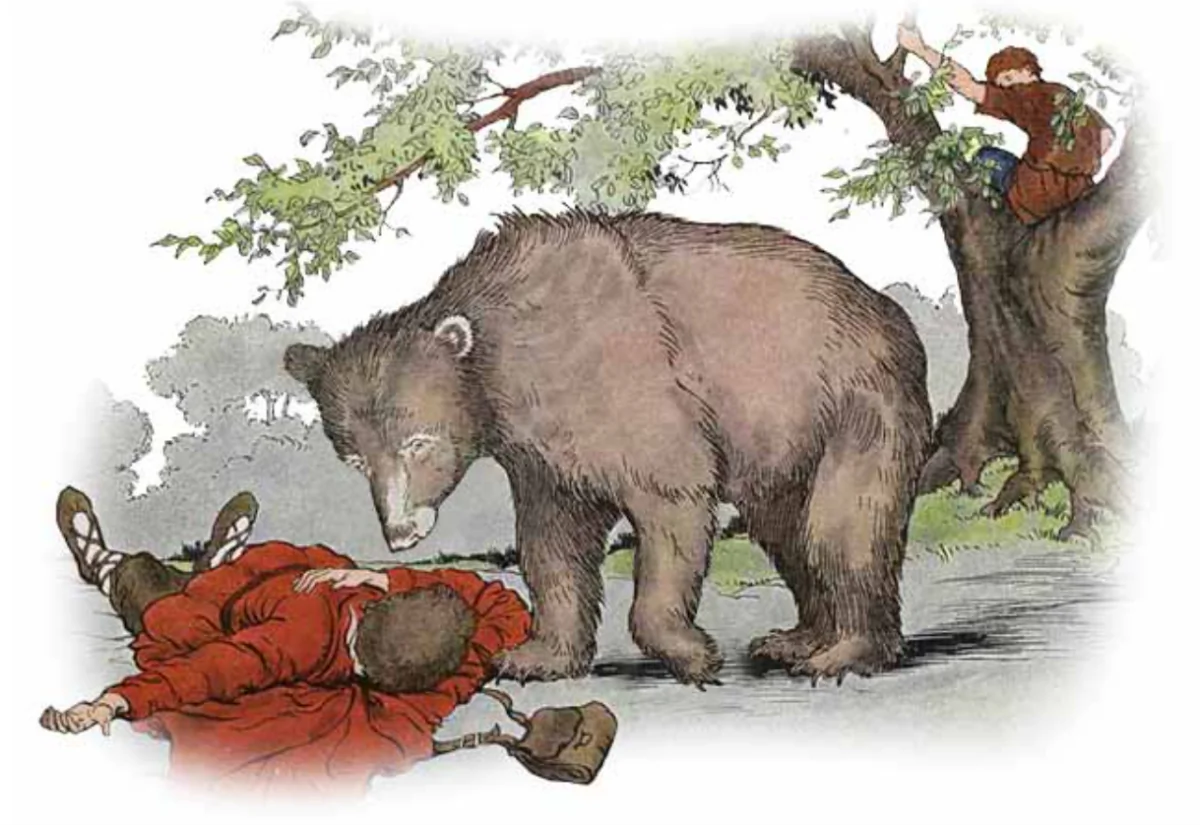
What this really shows us is that instinct overrides all intentions. That friends autonomic nervous system kicked in and sent him straight up a tree which he likely could never have climbed using his concious mind.
The other friend retained conscious intent and chose a useful second option not least because his friend was safe. I do wonder how often this has played out. I wonder if playing dead is also an autonomic response as well.
Often as not a bear will just wander off because it is not interested in us as prey. Understand a bear charge is usually triggered by distant motion when the bear cannot see properly or smell properly.
A prospector friend of mine did the tree scoot when a bear charged as well and dd not come to himself until he was well up the tree. What a rush and why i know what this story is missing.
.
Aesop fable "Two Travelers and a Bear." Library of Congress. (Public Domain)
Friendships That Endure: Aesop’s Fable, ‘Two Travelers and a Bear’
BY KATE VIDIMOS
MAY 26, 2023
https://www.theepochtimes.com/friendships-that-endure-aesops-fable-two-travelers-and-a-bear_5280710.html?
True friendship is characterized most by loyalty, for loyalty is the virtue that sustains friendships through any hardship. Loyalty gives us the courage to remain with friends, even when there is no advantage to be gained.
In his short story, “Two Travelers and a Bear,” Aesop shows how easily our friendship can be tested and how easy it is to fall short as friends.
Two friends walk together in the forest. Suddenly, a giant bear emerges from the forest, charging towards the two men. One of the men, “thinking of his own safety,” climbs a tree to get away from the bear.
In this moment, one friend abandons the other. Yet, before they entered the forest, each “mutually engaged to stand by each other in any danger they might encounter on the way.” And the other man, left defenseless and friendless, must now face the charging bear by himself.
With no tree to climb and nothing to defend himself with, the man drops face down to the ground and pretends to be dead, as he has heard that bears will leave dead bodies alone.
There are different versions of Aesop’s fable, which shed a different light to the tale. Some of the tales mentioned how the man who climbed the tree is a coward, while others remark about his courage and nimbleness. Some of the tales state how the man who feigned death could not move from fear, while others emphasize his abandonment by his friend.
Most importantly, many of the tales detail how both men promise to stand by each other during any adversity. Yet the one, whether considered courageous or cowardly by hiding in a tree, leaves his friend and breaks this promise.
Valued Friendship
Each version of Aesop’s tale differs a little from the others, but they all still focus on the lesson: “Misfortune is the test of friendship.” Aesop demonstrates that, in such difficult situations, we discover whether we just promise friendship with flowery words, or whether we prove our friendship with courageous, loyal deeds.
In his version of Aesop’s fable, Samuel Croxall points out: “All the declarations of kindness which are made to an experienced man, though accompanied by a squeeze of the hand, and a solemn asseveration, should leave no greater impression upon his mind, than the whistling of the hollow breeze which brushes one’s ear with an unmeaning salute, and is presently gone.” Words, ultimately, mean nothing if not followed by true, loyal deeds.
Loyalty is the proof of friendship and adversity is the trying fire. When we experience hardships with or through a friend, we must be a courageous friend that will bear through hardships willingly.
Let us not be friends in halves, but in wholes. True, loyal friendship gives the light and energy that makes a hard life in a dark world worth enduring.
No comments:
Post a Comment